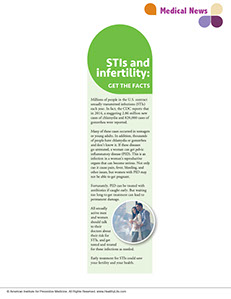SYMPTOM CHECKER
CONDITIONS
Male
Female
Child
Arm, Hand & Shoulder Concerns
Legs & Feet Concerns
Dental & Mouth Concerns
Ear & Nose
Eye Conditions
Head Conditions
Arm, Hand & Shoulder Concerns
Legs & Feet Concerns
Front
Back
Arm, Hand & Shoulder Concerns
Dental & Mouth Concerns
Ear & Nose
Eye Conditions
Head Conditions
Arm, Hand & Shoulder Concerns
Dental & Mouth Concerns
Ear & Nose
Eye Conditions
Head Conditions
Front
Back
Arm, Hand & Shoulder Concerns
Neck Links
Head & Neck Concerns
Arm, Hand & Shoulder Concerns
Neck Links
Head & Neck Concerns
Front
Back
Online Clinic
Wise Healthcare
STIs and infertility: get the facts
Print on Demand
Millions of people in the U.S. contract sexually transmitted infections (STIs) each year. In fact, the CDC reports that in 2014, a staggering 2.86 million new cases of chlamydia and 820,000 cases of gonorrhea were reported.
Many of these cases occurred in teenagers or young adults. In addition, thousands of people have chlamydia or gonorrhea and don’t know it. If these diseases go untreated, a woman can get pelvic inflammatory disease (PID). This is an infection in a woman’s reproductive organs that can become serious. Not only can it cause pain, fever, bleeding, and other issues, but women with PID may not be able to get pregnant.
Fortunately, PID can be treated with antibiotics if caught early. But waiting too long to get treatment can lead to permanent damage.
All sexually active men and women should talk to their doctors about their risk for STIs, and get tested and treated for these infections as needed.
Early treatment for STIs could save your fertility and your health.
This website is not meant to substitute for expert medical advice or treatment. Follow your doctor’s or health care provider’s advice if it differs from what is given in this guide.
The American Institute for Preventive Medicine (AIPM) is not responsible for the availability or content of external sites, nor does AIPM endorse them. Also, it is the responsibility of the user to examine the copyright and licensing restrictions of external pages and to secure all necessary permission.
The content on this website is proprietary. You may not modify, copy, reproduce, republish, upload, post, transmit, or distribute, in any manner, the material on the website without the written permission of AIPM.
2021 © American Institute for Preventive Medicine - All Rights Reserved. Disclaimer | www.HealthyLife.com
















































